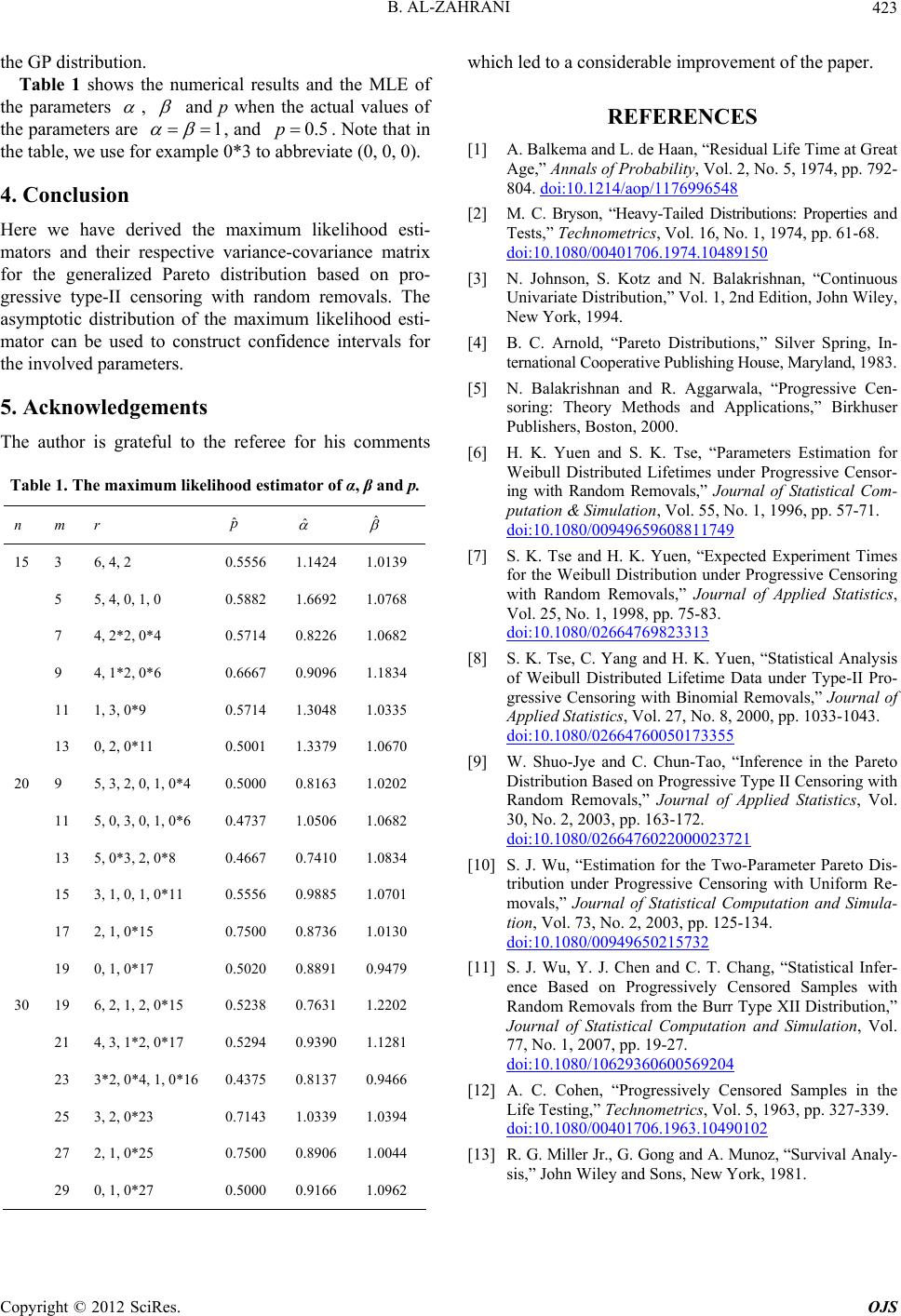
B. AL-ZAHRANI
Copyright © 2012 SciRes. OJS
423
which led to a considerable improvement of the paper. the GP distribution.
Table 1 shows the numerical results and the MLE of
the parameters
,
and p when the actual values of
the parameters are 1REFERENCES
, and . Note that in
the table, we use for example 0*3 to abbreviate (0, 0, 0).
0.5p
ˆ
[1] A. Balkema and L. de Haan, “Residual Life Time at Great
Age,” Annals of Probability, Vol. 2, No. 5, 1974, pp. 792-
804. doi:10.1214/aop/1176996548
4. Conclusion [2] M. C. Bryson, “Heavy-Tailed Distributions: Properties and
Tests,” Technometrics, Vol. 16, No. 1, 1974, pp. 61-68.
doi:10.1080/00401706.1974.10489150
Here we have derived the maximum likelihood esti-
mators and their respective variance-covariance matrix
for the generalized Pareto distribution based on pro-
gressive type-II censoring with random removals. The
asymptotic distribution of the maximum likelihood esti-
mator can be used to construct confidence intervals for
the involved parameters.
[3] N. Johnson, S. Kotz and N. Balakrishnan, “Continuous
Univariate Distribution,” Vol. 1, 2nd Edition, John Wiley,
New York, 1994.
[4] B. C. Arnold, “Pareto Distributions,” Silver Spring, In-
ter nat i ona l C o operat i v e Pub l i s hing Hous e , Mar yl and , 1983.
[5] N. Balakrishnan and R. Aggarwala, “Progressive Cen-
soring: Theory Methods and Applications,” Birkhuser
Publishers, Boston, 2000.
5. Acknowledgements
The author is grateful to the referee for his comments [6] H. K. Yuen and S. K. Tse, “Parameters Estimation for
Weibull Distributed Lifetimes under Progressive Censor-
ing with Random Removals,” Journal of Statistical Com-
putation & Simulation, Vol. 55, No. 1, 1996, pp. 57-71.
doi:10.1080/00949659608811749
Table 1. The maximum likelihood estimator of α, β and p.
ˆ
ˆ
n m r
15 3 6, 4, 2 0.5556 1.1424 1.0139
5 5, 4, 0, 1, 0 0.5882 1.6692 1.0768
7 4, 2*2, 0*4 0.5714 0.8226 1.0682
9 4, 1*2, 0*6 0.6667 0.9096 1.1834
11 1, 3, 0*9 0.5714 1.3048 1.0335
13 0, 2, 0*11 0.5001 1.3379 1.0670
20 9 5, 3, 2, 0, 1, 0*4 0.5000 0.8163 1.0202
11 5, 0, 3, 0, 1, 0*6 0.4737 1.0506 1.0682
13 5, 0*3, 2, 0*8 0.4667 0.7410 1.0834
15 3, 1, 0, 1, 0*11 0.5556 0.9885 1.0701
17 2, 1, 0*15 0.7500 0.8736 1.0130
19 0, 1, 0*17 0.5020 0.8891 0.9479
30 19 6, 2, 1, 2, 0*15 0.5238 0.7631 1.2202
21 4, 3, 1*2, 0*17 0.5294 0.9390 1.1281
23 3*2, 0*4, 1, 0*16 0.4375 0.8137 0.9466
25 3, 2, 0*23 0.7143 1.0339 1.0394
27 2, 1, 0*25 0.7500 0.8906 1.0044
29 0, 1, 0*27 0.5000 0.9166 1.0962
[7] S. K. Tse and H. K. Yuen, “Expected Experiment Times
for the Weibull Distribution under Progressive Censoring
with Random Removals,” Journal of Applied Statistics,
Vol. 25, No. 1, 1998, pp. 75-83.
doi:10.1080/02664769823313
[8] S. K. Tse, C. Yang and H. K. Yuen, “Statistical Analysis
of Weibull Distributed Lifetime Data under Type-II Pro-
gressive Censoring with Binomial Removals,” Journal of
Applied Statistics, Vol. 27, No. 8, 2000, pp. 1033-1043.
doi:10.1080/02664760050173355
[9] W. Shuo-Jye and C. Chun-Tao, “Inference in the Pareto
Distribution Based on Progressive Type II Censoring with
Random Removals,” Journal of Applied Statistics, Vol.
30, No. 2, 2003, pp. 163-172.
doi:10.1080/0266476022000023721
[10] S. J. Wu, “Estimation for the Two-Parameter Pareto Dis-
tribution under Progressive Censoring with Uniform Re-
movals,” Journal of Statistical Computation and Simula-
tion, Vol. 73, No. 2, 2003, pp. 125-134.
doi:10.1080/00949650215732
[11] S. J. Wu, Y. J. Chen and C. T. Chang, “Statistical Infer-
ence Based on Progressively Censored Samples with
Random Removals from the Burr Type XII Distribution,”
Journal of Statistical Computation and Simulation, Vol.
77, No. 1, 2007, pp. 19-27.
doi:10.1080/10629360600569204
[12] A. C. Cohen, “Progressively Censored Samples in the
Life Testing,” Technometrics, Vol. 5, 1963, pp. 327-339.
doi:10.1080/00401706.1963.10490102
[13] R. G. Miller Jr., G. Gong and A. Munoz, “Survival A nal y-
sis,” John Wiley and Sons, New York, 1981.